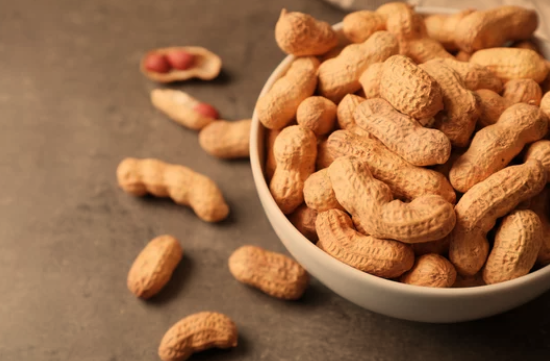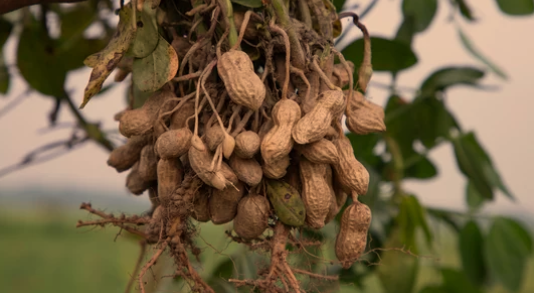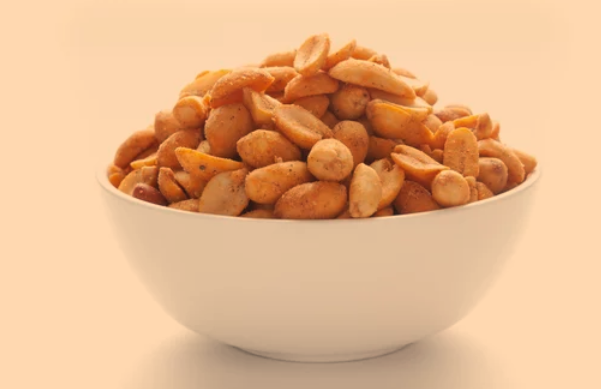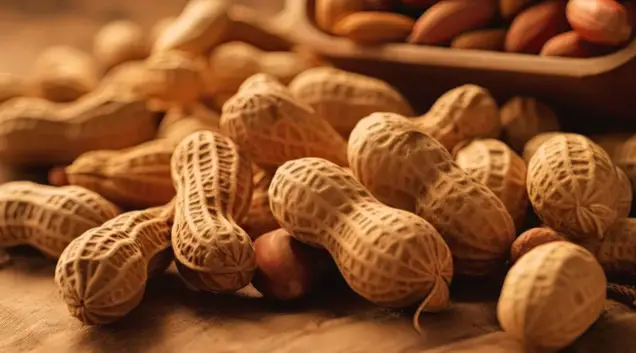Have you ever wondered where peanuts come from? Contrary to popular belief, peanuts do not grow on trees. Peanuts are legumes that grow underground.
You have probably seen peanuts in the shell, but have you ever seen them growing in the ground?
Peanuts start as seeds planted in the spring after the last frost. As the seeds germinate, the young peanut plants emerge from the soil.
The plants grow stems and leaves and flower above ground, but the peanut itself develops underground.
The peanut plant flowers above ground, and then the stems grow down into the soil.
Small peanut shells and seeds form underground and continue to grow and develop into the peanuts you know and love.
After a few months of growth, the farmer harvests the mature peanuts by digging them up and removing them from the ground.
Quite a fascinating process for such a popular snack and ingredient!
Now you know peanuts definitely don’t grow on trees.
They grow underground, hidden from view. The next time you crack open a peanut, think about its journey from a single seed to a delicious snack.
Peanuts Are Legumes, Not Nuts

do peanuts grow on trees?
Peanuts are legumes, not nuts. That’s right, peanuts grow underground, not on trees. They develop in the flower of a plant called Arachis hypogaea, more commonly known as the peanut plant.
The peanut plant is an annual herb that grows close to the ground. It has oval-shaped leaves, yellow flowers, and hairy stems. Once the flowers are pollinated, the petals fall off. The young ovary starts growing downward into the soil. This is where the magic happens.
Underground, the ovary matures into a seed. But not just any seed—a peanut seed. The peanut seed has a papery brown skin and contains 1-4 edible kernels inside. As the seeds develop, the plant’s stems and leaves above the ground die back.
About 120 days after planting, the pods containing the mature peanuts are ready to be harvested. Farmers use special machines to dig them up and shake off excess soil. Then the peanuts go through a curing process to dry them out. Finally, they’re ready to be shelled, sorted, and packaged for food.
Peanuts are a staple crop for millions of people worldwide. They’re not only delicious but also highly nutritious, packed with protein, healthy fats, vitamins, and minerals. So while peanuts may not grow on trees, these protein-packed legumes are still pretty amazing.
How Peanuts Actually Grow

You probably thought peanuts grew on trees, didn’t you? It’s an easy mistake to make, given their name. But peanuts are actually legumes that grow underground.
Peanuts start as seeds that are planted 2-3 inches deep in the soil after the last spring frost. As the seeds germinate, they send up shoots above the ground that produce the peanut’s yellow flowers. Bees pollinate the flowers, which then drop off as the peanut embryo develops underground into a pod.
The pod contains 1–4 peanuts and is what we know as the shell. While the shell hardens, the peanuts inside mature over the next 2–3 months. Once fully grown, the plant dies back, and farmers use specialized equipment to dig up the peanuts.
After harvesting, the peanuts go through a curing process to dry them out. The shells are then removed, leaving behind the edible peanuts we eat. Peanuts can be sold raw or roasted and are used in many foods, like peanut butter, candy, and oil.
Peanuts are a source of protein and healthy fats, as well as folate, niacin, magnesium, and antioxidants. They have been shown to help lower the risk of heart disease and aid weight loss. Though often thought of as a nut, peanuts are technically legumes, like beans and lentils.
Who knew such a little plant could produce so much nutrition and flavor? Next time you enjoy a peanut, appreciate the journey it took from a tiny seed to a household staple. Peanuts may not grow on trees, but their impact is huge.
The Life Cycle of a Peanut Plant

The life cycle of a peanut plant spans about 4 to 5 months. It starts with planting the seeds, called kernels, in the ground.
Peanut kernels are the seeds of the peanut plant. They are planted in the ground, where they germinate into tiny seedlings. The seedlings grow thin stems that extend into the soil. At the end of these stems, the seedlings develop flowers called pegs. The pegs extend into the ground and form small pods called shells. Inside these shells, the peanuts develop.
As the plant continues to grow, the shells and peanuts inside also grow larger. By late summer, the plant begins to mature. Its leaves start to turn yellow and die back. The peanut shells have now developed into the familiar peanut shape and contain fully grown peanuts.
At maturity, the peanut plant is ready to be harvested. A machine lifts the plant from the ground and shakes off the excess soil from the roots. Another machine then separates the peanuts from the plant. The peanuts are left to dry completely, usually for several days.
The final step is shelling and processing. Shelling machines crack open the peanut shells and separate the kernels inside. These raw peanuts can then be roasted, blanched, or processed into peanut butter, oil, and other products.
The peanut you enjoy in so many foods starts its life on the ground as a tiny kernel. Through a process of growth, flowering, and maturation, it develops into the popular peanut we all know and love. Though peanuts are legumes and not nuts, these protein-packed morsels remain an important crop and food source worldwide.
Common Types of Peanuts
Peanuts actually grow underground, not on trees. There are several common types of peanuts grown commercially. The two you’re probably most familiar with are Valencia and Virginia peanuts.
Valencia peanuts have three or four small, oval-shaped seeds in each pod. They have reddish-brown skin and are often used to make peanut butter. Valencian peanuts account for about 5% of U.S. peanut production.
Virginia peanuts, also known as Jumbo peanuts, contain two large seeds in each pod. They have a darker, copper-colored skin and are often roasted and sold in the shell. Virginia peanuts make up over 60% of U.S. peanut production and are considered the premium peanut for roasting and salting.
Runner peanuts are smaller than Virginia peanuts, with around five seeds per pod. They have a lighter brown skin and account for about 30% of U.S. peanut production. Runners are often used to make peanut butter, roasted peanuts, and peanut oil.
Spanish peanuts have small, oval seeds with a reddish-brown skin. They are usually roasted and sold in the shell. Spanish peanuts comprise only about 2% of U.S. peanut production.
There are a few other minor peanut types as well, including Valencia Reds, Tennessee Reds, and Georgia Reds. No matter the variety, peanuts provide many nutritional benefits. They are a good source of niacin, magnesium, vitamin E, protein, and healthy fats. An ounce of peanuts contains about 170 calories and 7 grams of protein.
While peanuts don’t actually grow on trees, their cultivation and harvesting are still impressive processes. Once the green pea-sized peanuts sprout yellow flowers above ground, their pods develop underground. About 120 days after planting, mature peanut pods are ready to be harvested, usually by a mechanized picker that lifts them from the soil. The pods are then cured, and the peanuts are shelled and packaged for distribution.
Interesting Facts About Peanuts

Peanuts are fascinating little legumes with some interesting facts you may not know.
Peanuts are not actually nuts.
Botanically speaking, peanuts are not nuts at all. They are legumes, like beans, peas, and lentils. Peanuts grow underground, unlike tree nuts.
Peanuts grow on vines.
Peanuts grow on vines that root in the ground and spread out. The peanut shells develop underground, around the root system. When harvested, the entire plant is pulled up, vines and all.
Peanuts are good for you.
Peanuts are high in healthy fats, plant-based protein, and various vitamins and minerals. They contain resveratrol, an antioxidant found in red wine that may help prevent heart disease. Peanuts can help lower cholesterol, promote blood flow, and keep you feeling full. Everything in moderation, of course.
The U.S. grows a lot of peanuts.
The United States is the third-largest producer of peanuts in the world. Major peanut-producing states include Georgia, Texas, Alabama, North Carolina, Florida, Virginia, and Oklahoma. Most commercial peanuts in the U.S. are grown for peanut butter and other food products.
Peanut butter was invented in the U.S.
Peanut butter was invented in the late 19th century in the United States. A St. Louis doctor created peanut butter in 1890, and it gained mainstream popularity in the early 1900s. Peanut butter is a very popular food in the U.S. and Canada. Most of the world’s peanut butter is consumed in North America.
George Washington Carver did not invent peanut butter.
Despite popular belief, George Washington Carver did not invent peanut butter. He was an agricultural scientist who helped popularize peanuts and developed many uses for them, but peanut butter had already been invented. Carver did help develop hundreds of products made from peanuts, sweet potatoes, and other crops.
Conclusion
So now you know the truth: peanuts don’t actually grow on trees. They grow underground in the soil. The peanut plant itself looks unassuming, but beneath the surface, it’s busily producing those delicious nuts we all know and love. While peanuts remain an agricultural wonder, producing massive amounts of a staple crop with little input, their cultivation does come with challenges. As with any crop, peanuts require the right environment, nutrition, and care to thrive. But when conditions are right, a single peanut plant can produce over 100 peanuts—enough to keep you snacking for a while! Next time you crack open a peanut, take a moment to appreciate the humble plant and the farmers that made it possible. Peanuts may seem ordinary, but their story is anything but.




